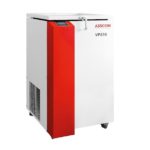Vapor phase soldering
 Vapor Phase Soldering, also well known as Condensation Soldering, uses for the heating-up process of the assemblies the thermal energy which is emitted by phase change of the heat transfer medium from gas-like to liquid state. This phase change (Condensation) at the complete surface of the solder piece lasts as long until the assembly has reached the temperature of the vapor. Due to the high vapor density and the liquid film as a result of condensation, the complete heating-up process takes place at an oxygen free environment. The transferred quantity of heat is linear to the supplied heating energy.
Vapor Phase Soldering, also well known as Condensation Soldering, uses for the heating-up process of the assemblies the thermal energy which is emitted by phase change of the heat transfer medium from gas-like to liquid state. This phase change (Condensation) at the complete surface of the solder piece lasts as long until the assembly has reached the temperature of the vapor. Due to the high vapor density and the liquid film as a result of condensation, the complete heating-up process takes place at an oxygen free environment. The transferred quantity of heat is linear to the supplied heating energy.
Following advantages are resulting with these physical principles:
- No more overheating of the assemblies, because the boiling point of the heat transfer fluid defines the maximal soldering temperature. Therefore vapor phase soldering is ideally usable for lead free solder processes.
- Continuous heating-up at the complete assembly even with different assembly parts and assembly mass.
- Oxygen free soldering process without application of any protective gas.
- Efficient use of energy due to the high heat transfer coefficient of the medium, compared with air, nitrogen or radiation. Therefore operating costs are significant reduced compared with the other Soldering Technologies as radiation and convection.